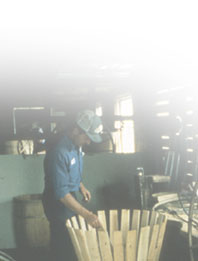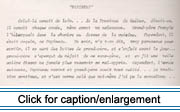|
 Many
oral traditions described in this section are shared by Maine Acadians
and their "English" neighbors in New England (E. Ives, pers. comm. 1993).
Others were brought to the New World from France by Acadians and French
Canadians during the 17th and early 18th centuries. Many traditional songs,
folktales, legends, and beliefs from this period have passed from one
generation to the next. They survive today in French settlement areas
of the U.S. and Canada, often appearing to be closer to the 17th century
forms than presently occurs in France. The co-occurrence of some traditions
in the Upper St. John River Valley and in Louisiana strengthens the assertion
that their oral traditions derive from similar Old World sources, given
the fact that the two populations have been separated for nearly 240 years
(Ancelet 1987: 277ñ288). Additional research is required to determine
the vitality and prominence of Old World forms in the Valleyís oral tradition. Many
oral traditions described in this section are shared by Maine Acadians
and their "English" neighbors in New England (E. Ives, pers. comm. 1993).
Others were brought to the New World from France by Acadians and French
Canadians during the 17th and early 18th centuries. Many traditional songs,
folktales, legends, and beliefs from this period have passed from one
generation to the next. They survive today in French settlement areas
of the U.S. and Canada, often appearing to be closer to the 17th century
forms than presently occurs in France. The co-occurrence of some traditions
in the Upper St. John River Valley and in Louisiana strengthens the assertion
that their oral traditions derive from similar Old World sources, given
the fact that the two populations have been separated for nearly 240 years
(Ancelet 1987: 277ñ288). Additional research is required to determine
the vitality and prominence of Old World forms in the Valleyís oral tradition.
The American Dialect Society recorded oral histories in Fort Kent, Maine,
in the 1930s. Many traditional tales were recorded in the Valley by GeneviËve
Massignon in the 1940s. As recently as the 1970s, Roger Paradis and the
Aroostook County Oral History Project recorded folktales on the American
side of the Valley, while folklore students from the UniversitÈ de Moncton
recorded tales on the New Brunswick side. Since 1992, the Acadian Archives/Archives
acadiennes at the University of Maine at Fort Kent has been identifying
and recording performances by local traditional musicians, singers, and
story-tellers as part of their St. John Valley Folk Arts Survey. They
have so far identified 50 musicians, 17 singers, and 3 story-tellers.
Valley residents share with other French Catholics a common body of stories
about mythical creatures. The lutins are the only widespread example
of fairy-like creatures found in French folklore in North America. The
lutins are said to ride farmersí horses at night and plait the
horsesí tails. One resident told a project researcher about lutins
who live in caves and come out only at night. He explained that they are
so small that a locked door cannot keep them out; they can pass through
a keyhole. Stories about lutins are told in all areas where Acadians,
and French Canadians and their American descendants live.
|
 |
 |
Other supernatural creatures present in the folklore of the Upper St.
John Valley are also found in French-Canadian, Acadian, and Franco-American
folklore. Feux-follets are spirits of the damned that temporarily
leave a personís body and wander at night in the shape of a small flame.
Loups-garous (werewolves) are another form of night creature. The
belief is that sinners may be transformed into black bears or dogs, in
which shape they wander each night until someone draws blood from them,
thereby breaking the curse.
The oral traditions of Maine Acadians include many other forms. One genre
consists of traditional sayings used by adults to control their children
or explain sensitive topics to them. For instance, one local resident
remembered his parents telling him about le Bonhomme Sept-heures,
a fearful character who would visit unpleasant deeds upon young children
if they did not go to bed at the designated hour.
 Another form of oral tradition is the prÈsage (portent or prediction).
Albert (1969) has recorded examples of these, such as: "If a bird hit
a window in flight, someone has passed away" and "The weather on the third
day of the month predicts the weather for the month," which is expressed
by the saying le trois fait le mois. Native and migratory birds
figure prominently in this genre, as in other oral forms (see Michaud
1972 and Cyr 1977). Michaud, Cyr, Albert, and others have recorded a wide
range of folk speechways, including tongue twisters (vires-langue),
proverbs (proverbes), metaphors (mÈtaphores), riddles (devinettes),
and nursery rhymes (formulettes Èducatives). Don Levesque, general
manager of the St. John Valley Times, invited readers to
submit prÈsages, dictons, and patois (sayings) during
the winter of 1993ñ94. Readers responded enthusiastically, several sharing
their own collections of local sayings.
Another form of oral tradition is the prÈsage (portent or prediction).
Albert (1969) has recorded examples of these, such as: "If a bird hit
a window in flight, someone has passed away" and "The weather on the third
day of the month predicts the weather for the month," which is expressed
by the saying le trois fait le mois. Native and migratory birds
figure prominently in this genre, as in other oral forms (see Michaud
1972 and Cyr 1977). Michaud, Cyr, Albert, and others have recorded a wide
range of folk speechways, including tongue twisters (vires-langue),
proverbs (proverbes), metaphors (mÈtaphores), riddles (devinettes),
and nursery rhymes (formulettes Èducatives). Don Levesque, general
manager of the St. John Valley Times, invited readers to
submit prÈsages, dictons, and patois (sayings) during
the winter of 1993ñ94. Readers responded enthusiastically, several sharing
their own collections of local sayings.
Strong beliefs relative to the cycle of the moon persist in the Valley.
One resident assured researchers that potatoes must be planted in the
dÈcroÓt de lune (waning of the moon). A long-time farmer, he explained
that the lunar cycle affects birthing, planting, tree cutting, and many
other aspects of life. A common belief among farmers is that plants which
grow above the ground should be planted en lune profitante (during
the waxing of the moon), while root crops should be planted in the waning
of the moon.
Oral tradition in the Upper St. John Valley has its share of tall tales,
stories about odd characters, and other humorous tales. The ever-present
international border has figured in a great many tales about smuggling,
including stories about five-gallon tins of concentrated rum bearing the
label of the "White Hand." In most of these tales, the cunning and trickery
of the smuggler is emphasized, but some reveal the smugglerís ignorance
or naÔvetÈ in dealings with customs agents.
 Many stories are told about an itinerant beggar nicknamed Papineau, who
spent years wandering through the Valley. Hundreds of anecdotes about
Papineau are contained in the UniversitÈ de Monctonís folklore archive
and in the Northeast Archives of Folklore and Oral History of the Maine
Folklife Center, University of Maine (Orono). The stories describe Papineau
as a frightening figure who could eat more than any man and who could
cast spells if people refused to give him food and lodging.
Many stories are told about an itinerant beggar nicknamed Papineau, who
spent years wandering through the Valley. Hundreds of anecdotes about
Papineau are contained in the UniversitÈ de Monctonís folklore archive
and in the Northeast Archives of Folklore and Oral History of the Maine
Folklife Center, University of Maine (Orono). The stories describe Papineau
as a frightening figure who could eat more than any man and who could
cast spells if people refused to give him food and lodging.
The themes of sacrifice and hardship associated with the early years
of settlement in the Upper St. John Valley are embodied in oral tradition
for some residents of the area. During the summer of 1991, Brassieur and
his fellow fieldworkers (1992) heard stories about Acadian pioneers erecting
a cross at the point of their arrival in the Valley, and stories about
pioneers who arrived without possessionsónot even toolsóand who proceeded
to establish villages and build houses. Fieldworkers heard a story about
two brothers who, after following long and separate routes to the Upper
St. John Valley, ended up settling and living out their lives at different
locations in the Valley. Neither one ever realized that his brother lived
so near. These and other stories, some of which are based on Thomas Albertís
Histoire du Madawaska ([1920] 1985), have become part of
the institutionalized history of the Valley.
Another legendary figure associated with the theme of self-sacrifice
is "Tante Blanche." During a 1797 famine the woman upon whom the legend
is based, Marguerite-Blanche Thibodeau, performed many remarkable acts
of charity. Tante Blanche was the oldest woman at Violette Brook, where
she resided. Wearing snowshoes, she brought extra clothing and provisions
to people suffering from hunger and cold, while the men from the community
attempted to hunt for food. In this way, she is believed to have saved
many lives (Albert [1920] 1985: 57). With time, Tante Blanche became renowned
for her selflessness and became an object of general veneration. She was
said to be able to cure the sick and the tormented, to chase out evil
spirits, to find lost objects, and even to reconcile enemies (Albert 1969:
58). She is memorialized at the Madawaska Historical Societyís Tante Blanche
Museum at St. David.
Tante Blanche is not the only woman who is remembered for her devotion
to the people of the Valley. Henriette Pelletier, who was known as "Tante
Henriette" or "la Capuche," was born in Saint-Alexandre, QuÈbec,
in 1861 and lived near Frenchville, Maine, from 1874 until her death at
the age of 90. Henriette was a midwife who delivered over 500 babies.
She also cared for new mothers and their children and dispensed herbal
medicines to the sick. She sometimes walked for miles to reach her patients
and was always ready to offer her services when called upon (Paradis 1981).
Finally, a host of traditional sayings are repeated and passed on in
the Valley. Albert (1969: 108) recorded the presence of many expressions,
some Acadian, some French Canadian, and others that are common to all
French communities in North America, such as the traditional New Yearís
greeting: "Bonne, sainte et heureuse annÈe, et le paradis ‡ la fin
de vos jours" (Good, holy, and happy New Year, and Paradise at the
end of your days). Michaud (1972) describes the social contexts in which
alternative expressions connoting abundance and generosity may be invoked.
Examples of sayings recorded by Albert (1969) include "il mord dans
le fer" (he is biting iron) to describe an angry person.
|
|

